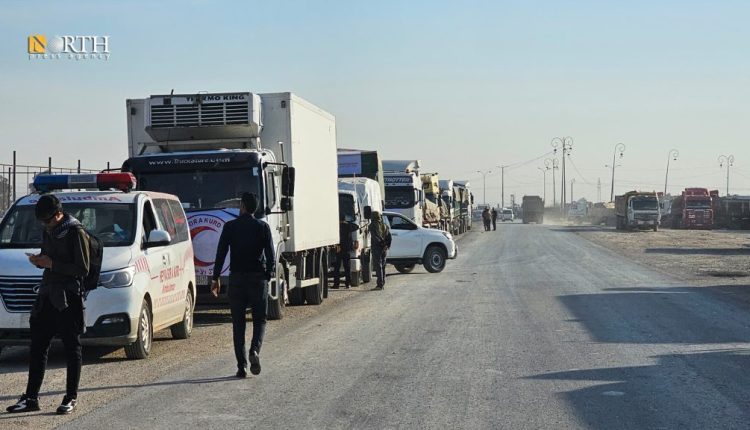Kurdish Red Crescent Prepares Second Humanitarian Convoy to Syria’s Coast Amid Worsening Conditions
By Kardo Roj
QAMISHLI, Syria (North Press) –
The Kurdish Red Crescent is set to dispatch its second humanitarian aid convoy to Syria’s coastal region on Friday, as humanitarian conditions continue to deteriorate following days of intense clashes in the area.
The convoy, scheduled to depart from Qamishli in northeast Syria, comes less than a month after the organization’s initial mission, which delivered emergency assistance from Hasakah to conflict-affected communities along the western coastline.
According to sources familiar with the operation, the new convoy will include dozens of trucks carrying essential supplies including food, medical equipment, and hygiene kits. The aid is intended for civilians impacted by a recent wave of violence that has left basic services severely disrupted.
“People in the coastal areas are in urgent need of assistance,” a humanitarian coordinator involved in the effort told North Press. “The ongoing hostilities have halted access to health and relief services, exacerbating the suffering of thousands.”
The coastal region, which includes cities like Latakia and surrounding countryside, has witnessed intermittent armed confrontations over the past month, leading to widespread displacement and the suspension of critical infrastructure. Local sources report that at least four consecutive days of clashes earlier this month caused major disruptions to electricity, water distribution, and medical care.
While the region is traditionally outside the operational scope of the Kurdish Red Crescent, the escalation in humanitarian need has prompted exceptional cross-regional coordination between local aid groups and civil society actors affiliated with the Autonomous Administration of North and East Syria (AANES).
“Our commitment to humanitarian principles drives this mission,” said a Kurdish Red Crescent spokesperson. “This is about solidarity and support for civilians, regardless of geography or politics.”
On March 18, the Kurdish Red Crescent participated in a similar humanitarian initiative, dispatching its first aid convoy from Hasakah to the coastal region. That mission successfully reached several areas affected by the violence and distributed emergency supplies to families in need.
Photos shared at the time showed long lines of trucks winding through central Syria, escorted by local coordinators and monitored by neutral humanitarian observers to ensure delivery without political interference.
International NGOs and UN agencies have praised local Syrian organizations for stepping in where cross-line aid deliveries remain limited or delayed due to logistical and political barriers.
Although Syria remains divided by complex frontlines and competing authorities, humanitarian needs often transcend those divisions. Organizations like the Kurdish Red Crescent have emphasized the importance of maintaining neutrality and focusing on the well-being of civilians, particularly during times of acute crisis.
The AANES, which oversees northeast Syria and provides administrative support to the Kurdish Red Crescent, has echoed calls for unhindered humanitarian access across all regions of the country. In recent statements, AANES officials stressed that aid operations should not be politicized or obstructed by ongoing conflict dynamics.
“Humanitarian work must be protected and facilitated,” an AANES official told North Press. “This convoy is a message of unity from northeast Syria to communities suffering elsewhere.”
With humanitarian conditions in the coastal region still volatile, local actors anticipate that further aid missions may be necessary in the coming weeks. Logistics teams are reportedly coordinating with civil councils and community leaders in the region to ensure safe delivery and effective distribution.
As Syria continues to face both armed conflict and economic hardship, such grassroots initiatives underscore the evolving role of local humanitarian organizations in bridging gaps where international access remains limited.
Whether this second convoy marks a sustained channel of support or remains an exceptional response will likely depend on developments on the ground and the willingness of all parties to facilitate safe humanitarian corridors.

